
Photographers beware: Leaning out to get the perfect shot of the magnificent Puente Nuevo bridge in Ronda, Spain, can result in a long drop – 390 feet to be exact. And while the bridge may be the star of the show in Ronda, the supporting cast of awesome views and medieval splendor also draws quite a crowd.
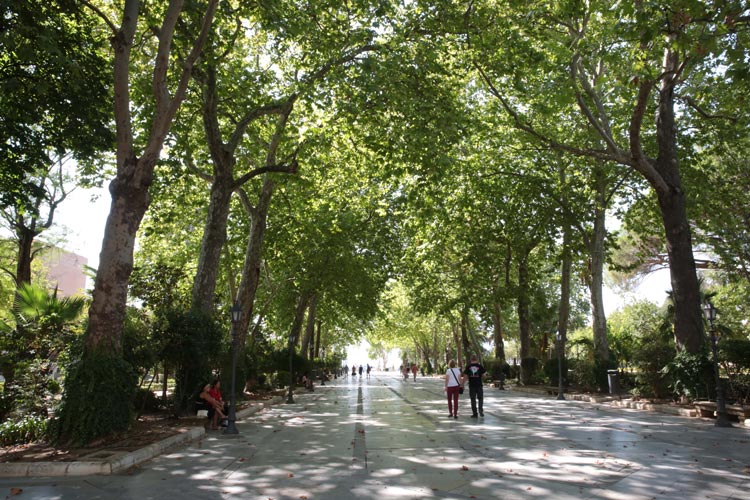
All About Ronda, Spain
Dating to the 6th century B.C., Ronda is one of the oldest towns in Spain and arguably the most intriguing. Located in the Malaga region of southern Spain, getting to Ronda is a bit of a challenge.
The roads are steep and winding, but the scenery makes it worth your while. Visitors enjoy a panorama of terraced hills, olive groves and cobalt skies as they wend their way to Ronda’s lofty heights.
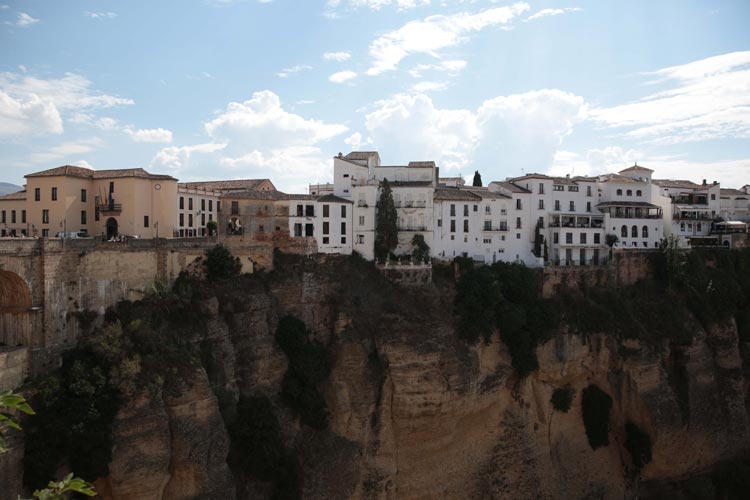
Dizzying Heights of Ronda, Spain
On arrival, we made our way to Alameda del Tajo. This lovely park has a lookout point like no other – you can see for miles. This plaza is situated on a cliff so sheer it will make your head spin. Step away if you’re squeamish about heights.
A round pavilion situated on the plaza hosts local musicians, and on the day of our visit it was occupied by a group playing Peruvian pipe music. The combination of epic views and haunting melodies made this an unforgettable travel moment.
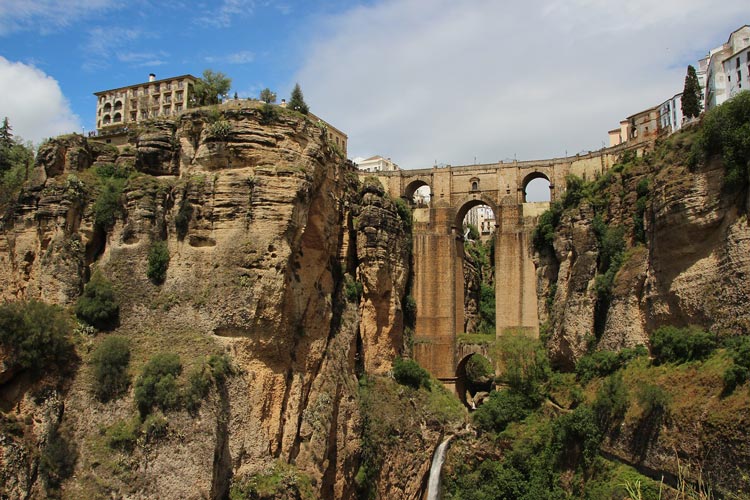
The Big Bridge
From there we strolled along cobblestone streets to the Puente Nuevo bridge. This is one of Ronda’s most photographed sites and it’s not hard to see why. An incredible feat of engineering, the bridge towers 390 feet above the canyon floor and was built without the aid of modern technology.
While crossing the bridge we cautiously peered over the side. It’s perfectly safe, but a sudden gust of wind had me gripping the stone balustrade extra tight.
Not only is the Puente Nuevo an architectural wonder, it has a fascinating history. The first attempt at bridging the Guadalevin River was in 1734. That bridge had one arch, was poorly built and, after seven years, collapsed, killing 50 people.
Without the bridge, it was very difficult to get from one part of town to the other. A visit to the far side entailed a heart-pounding trek through the El Tajo Gorge, a sheer limestone ravine that drops from the bridge to the craggy river bed below.
The construction of the second causeway in 1751 was a great boon to the citizens of Ronda – unless, that is, you were prone to breaking the law.
The middle chamber of the new bridge was used as a prison, from which I’m guessing few escaped. Another grim fact – during the 1936-1939 civil war, the prison doubled as a torture chamber for captured opponents, and some unlucky inhabitants were thrown from the windows to the rocks below. The chamber now serves a happier function, as it contains an exhibition describing the bridge’s history.
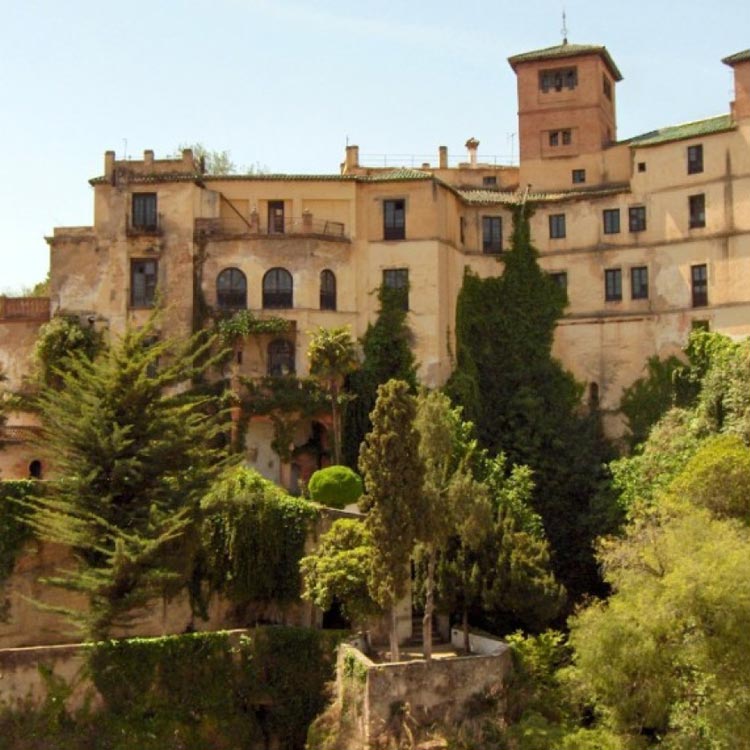
The Palace and Water Mine
La Casa Del Rey Moro is another visitor favorite. This palace was reputedly the home of a Moorish king, but actually was built in the 18th century long after the Moors’ occupation.
While the building itself is not always open to the public, visitors will enjoy an excellent re-creation of a Moorish garden, as well as a fascinating feature found in the spooky netherworld beneath the palace. Don’t miss the Water Mine.
The Water Mine was built by the Moors in the 14th century as a means to protect the city’s water supply during times of war. Visitors enter through the palace gardens and descend 231 steps that are carved into a rock wall. Luckily there’s a handrail since the descent can be damp and slippery.
The tour leads 200 feet down to the galleries of a shadowy underground fortress, and then to the riverbed. Here you step from the gloom into a beautiful grotto filled with sunshine and sparkling water. Now it’s time to imagine what it must have been like to carry buckets of water back up all those stairs.

Plaza De Toros
Our next stop was the Plaza De Toros bullfight ring. This is an interesting place even if you’re not a fan of this controversial sport. Here you can walk around the arena, visit the equestrian center and check out the chute where the bulls come charging into the ring.
Be sure to visit the Bullfight Museum. It’s located under the stadium where it’s nice and cool, a welcome change from the simmering heat outside. You will see authentic bullfighting costumes, photos and stories of bullfighters and matadors, along with a fascinating history of the sport itself.
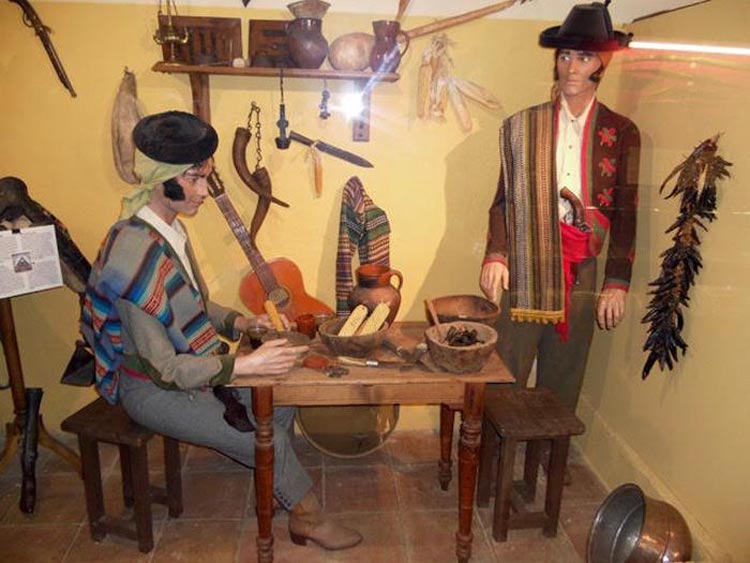
The Bad Guys
In the late 19th century Spain was plagued by bandits and highway robbers. The Bandolero Museum chronicles the lives and legends of these shady citizens. You will see paintings and dioramas, along with ancient knives, pistols and blunderbusses.
Other displays feature histories and personal documents, as well as newspaper articles alternately calling for the capture of, and protection for the gritty bandits. This is a fun stop, which is located near the bull ring.
Ronda is a unique and delightful place to visit. In addition to the main sites, there’s a fun shopping district and a variety of cozy restaurants.
All in all, the Ronda Show gets a 4-star review from me. And while it won’t be coming to a theater near you, you can certainly go to it the next time you visit Spain.
If you go:
Rondatoday.com is a great source for all things Ronda related.
Palace and Water Mine
Calle Cuesta de Santo Domingo, 9, 29400 Ronda, Málaga, Spain
Phone: +34 617 61 08 08
Hours: Opens 10 a.m.
Tickets approximately $6
Bullfight Museum
Calle Virgen de la Paz, 15, 29400 Ronda, Málaga, Spain
Ticket Office Phone+(34) 952 874 132
Open throughout the year except on bullfighting days.
Hours: 10 a.m. – 6 p.m.
Tickets: 8 euros / with audio guide 9.5 euros
Museo del Bandolero
Calle Armiñán, 65, 29400 Ronda, Málaga, Spain
Ticket Office Phone – (34) 952 877 785
Hours: Monday to Friday and Sunday,11 a.m.-7:30 p.m.; Saturday and bank holidays,11 a.m.-8 p.m.
Tickets: Single 3.75 euros / Groups 2 Euros
Lodging:
For the budget-minded traveler – Hotel Ronda
Calle Ruedo Doña Elvira, 12, 29400 Ronda, Málaga, Spain
+ (34) 952 87 22 32
For luxury accommodations – the Vida Rustia
Vacation villas for visitors to Andalucia
Phone – +44 (0) 208 099
Author Bio: Geanie Roake is a book lover who has the good fortune to work in a library, and a wanderer who loves to write about her adventures. Join her for more travel tales at https://libraryladytravels.com/
- Palawan Perfection: Exploring the Philippines’ Last Ecological Frontier - July 13, 2025
- A Journey to Ashland, Oregon’s Shakespeare Festival - July 13, 2025
- The Ultimate Guide to Cairo’s Top Three Museums: Which Should You Visit? - July 12, 2025
